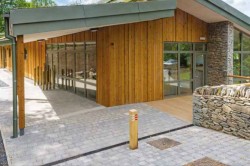Timber has the ability to soften and accentuate buildings and landscapes like no other material and offers a winning combination of versatility, economy and environmental credentials to any building project. Janet Sycamore from the Timber Decking & Cladding Association explains the options surrounding service life.
To make the best use of timber there needs to be an appreciation of its properties and behaviour. Well-designed and installed timber cladding acts as a rain screen with a well-drained and ventilated cavity behind the boards. With careful detailing and materials selection, timber will perform for decades. Three common aspects to remember:
- Allow for natural movement in the design, i.e. the natural cycle of expansion and contraction that occurs with changes in seasons, by having appropriate expansion gaps, suitable fixings and fixing points and adequate support
- Ensure the moisture content of the timber is appropriate at the point of installation
- Be aware that timber is a natural material and its appearance will change over time, eventually weather to a mellow silver grey colour. Take steps to prevent uneven weathering where possible.
There is plenty of technical information available online to help the specifier. Recently BS8605 External Timber Cladding Part 1: Method of specifying was published. This is a useful reference tool and covers aspects under the control of the manufacturer up to the point where the cladding leaves the factory. Part 2, which will cover cladding once it leaves the factory, is still being written.
Use the following as a specifier check list.
- Budget: price varies significantly. Naturally durable species from which all sapwood is excluded tends to cost more than less durable softwoods protected by an industrially applied wood preservative. Cost relates to availability of a species, quality, performance and level of processing involved.
- Desired service life: the prediction of service life is not precise because a range of factors can affect it but generally length of service will relate to the durability of the timber against fungal and insect attack. Durability is either inherent in the species or conveyed by a factory-applied wood preservative or modification process.
- Durability against decay and insects: cladding is a BSEN335:1 Use Class 3 application – select material suitable for this end use that will achieve the service life you require.
- Fire retardant treatment: if fire protection is a stipulation under building regulations, always check to ensure that the cladding species, profile size and cavity design reflects accurately the Certificates that accompany the treatment under consideration.
- Design detailing: careful detailing to prevent moisture retention and to minimise the effects of moisture movement (expansion and contraction) are essential in all designs. Materials with enhanced durability can provide an insurance against detailing failures and poor installation practice/maintenance.
- Is a natural or coated finish required: a coating will need to be maintained according to product guidelines. At least one coat, factory applied on all sides, is the best approach.
- What maintenance regime is acceptable: if maintenance, repair and replacement is likely to be difficult and costly then the highest durability of cladding permitted by the budget should be chosen. All coated cladding will require recoating at some point.
- Resistance to impact damage and vandalism: species with a low density (physical hardness) are susceptible to impact and surface damage and should never be used at low levels where there is the potential for abrasion, scraping or vandalism.
- Sustainability certification: source certification schemes from managed forest resources are now well established for both home grown and imported species. Look for materials from FSC and PEFC-accredited sources for absolute reassurance.
- Quality: for any given species, appearance, strength and durability are determined by the quality selected. Knot size, knot frequency, grain orientation, type of machining and whether sapwood is included or excluded all have a bearing on quality. Where naturally durable, preservative treated or modified woods are specified, the TDCA recommends that the cladding is processed using a Factory Production Control system (FPC), with third party accreditation such as ISO9001.
- Supplier support services: make sure that the supplier you select has the ability to provide the range of support services required prior to, during and after installation. Samples supply, supply volume and quality consistency, technical expertise on the chosen material, handling advice and snagging and quality dispute resolution policies are all critical service factors to be considered.









